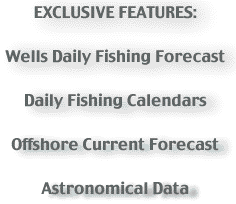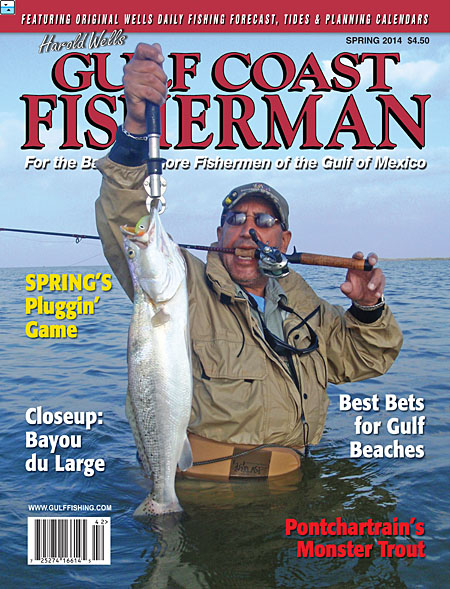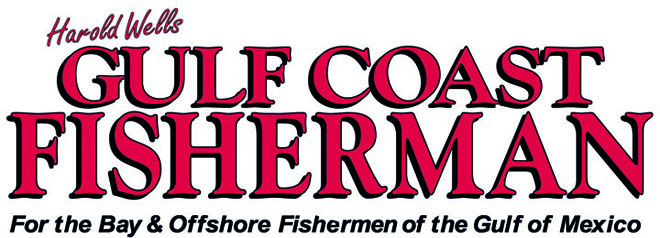
The Saltwater Magazine for Gulf Coast Fishing!
FISHING FORECASTS
| FISHING CALENDARS | ARTICLES | ADVERTISE
| SUBSCRIBE

by Colby Sorrells
Tackle Time - Winter 2014
Another fishing lure in pink. Why pink? For many years the color pink has been associated with coastal fishing. Why does this color attract fish and fishermen?
West coast salmon fishers often use pink in their flies and spoons. Pink is also the color of salmon eggs, and big rainbow trout love to eat salmon eggs. Different salmon in different rivers produce different sizes and colors of salmon eggs. Most fishing guides carry a box filled with different shades and sizes of pink beads to imitate the salmon eggs for their river at any particular time.
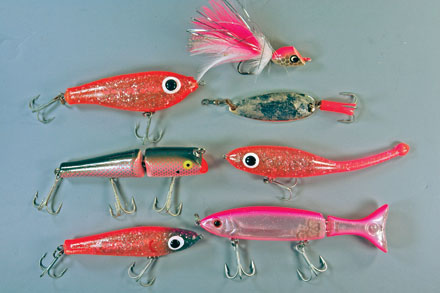
Pink also mimics the flesh of rotting salmon that is so vital to the river's salmon use for spawning. Salmon flesh not only feeds the rainbow trout and other fish found in the rivers but also helps fertilize the river itself, providing a better home for next year's salmon fry. The entire ecosystem from old fish to young fish and even old and young bears depends on that pink colored flesh. From Alaska to California, pink, flesh colored flys and lures catch Pacific salmon.
Fluorescent paints were experimented with in the 1930s and perfected right after World War II. The military learned how fluorescent colors could help personnel locate things like handles, steps, and signs during the dark hours of the night. Fluorescent painted parts were used on aircraft carriers, submarines and other places.
Fluorescent colors, often referred to as "hot", are very different from non-fluorescent colors. Paul Johnson, in 1984's The Scientific Angler, discusses the effect of colors under water. "The reds were jet black, the oranges were black, although the blues and greens showed negligible change. By contrast the fluorescent reds, oranges, and yellows still glowed brightly," Johnson reported.
Dr. Colin Kageyama, in his book What Fish See, discussed colors under water further. He states, "In very clear water, blue and yellow in non-fluorescent and fluorescent green and white were highly visible.
In water of moderate clarity, non-fluorescent white, yellow, and orange were easily seen, as were the fluorescent green and orange.
In water with a visibility of less than five feet, the colors best seen by scuba divers were white, yellow, and orange in non-fluorescent colors and orange or red in fluorescent colors." Dr. Kageyama's results are verified by other books on fish sight including Phil Rabideau's The Master Angler and Dr. Thomas Sholseth's How Fish Work.
Simply stated, fish (and people) under water see fluorescent colors better than non-fluorescent colors. Fluorescent pink is more visible to fish than non-fluorescent pink. Pink lies between red and orange on the color scale, so regular pink fell in line with these colors while under water. In other words, it looked black. But fluorescent orange, pink or red are visible even in highly turbid waters.
The color pink was not found on many fishing lures until after World War II. One of the earliest lures to use pink was made by Nichols Lure Company of Corpus Christi, Texas. Nichols included pink eye pearl as one of 17 colors they started selling in 1946. These lures used regular pink as part of their paint scheme.
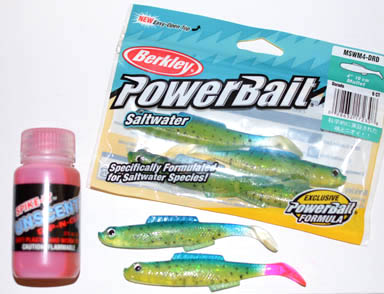
If you can't find your favorite plastic in pink, you can always buy a dip - such as Spike- It - Dip-N-Go, and DIY. |
Two particular fishing lure companies probably had more to do with the acceptance of pink as a fishing lure color than any other company. The first company was Corpus Christi's Doug English Lure Company which made the Bingo lure line. English and Texas coastal legend Anton "Pluggin Shorty" Stetner helped introduce many anglers to artificial lures, and many of those lures were made in pink. The petroleum based plastic has a natural pink color that often includes shades of purple, red, orange and even yellow. For many years it was hard for tackle collectors and fishermen on the hunt for used lures to open a tackle box along the Texas coast without seeing a pink Bingo inside.
The second company, L&S MirrOlure of Florida, started making a lure they called red but it looked very much like pink. They were also one of the first companies to work with true fluorescent colors. Not long after L&S experimented with their first fluorescent colors, they began to make fluorescent or hot pink lures. One particularly effective MirrOlure color is called the "Texas Chicken." The exact origin of the color and name are lost to history. The pink back, silver side and yellow belly lures are still found in many tackle boxes today and MirrOlure still offers lures in this color. A recent variation, the Electric Chicken replaces the yellow belly with chartreuse.
The bass fishing crowd discovered pink in the 1980s, and many fished a color they called "Bubble Gum." This is a regular pink, not a fluorescent pink.
Using a small, pink plastic tab on a spoon has long been a standard arrangement for coastal fishermen. The little pink tab often makes the difference between fishing and catching fish. So, for many spoon users, it's hot pink or nothing.
Not sure if your pink lure is fluorescent pink or not? Loon Outdoors is one of several companies selling small UV lights for less than $20. Place your lure in a dark room and hit it with the UV light. Fluorescent colors glow like they are powered by a battery. Non-fluorescent colors appear dull gray or even black. If you want to have some fun, take the small UV light with you the next time you visit one of the large fishing tackle retailers and test out a few colors. Cup the lure between your hands and turn on the light. You may even find some markings on the lures, like gill marks or fake eyes at the lure tail end that you didn't realize were there.
Fluorescent pink lures are more easily seen by fish. Isn't that the whole idea behind artificial lures, to be seen by fish? And, if anyone ever asks why you're fishing a pink lure, just tell them. The real reason to use a pink lure is fish like them, and they work. That's "Why Pink!"
One Year (4 issues) Only $15.00 Single Copy Digital Issue - $3.95 |
FEATURED IN EVERY ISSUE!
Wells Daily Fishing Forecast Monthly Fishing Calendars
Monthly Fishing Calendars
(3
months in every issue)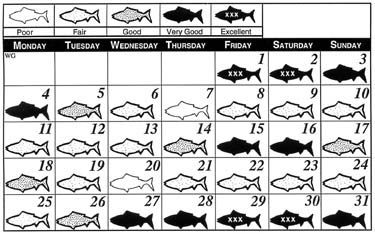 Advance
Planning Calendars
Advance
Planning Calendars
(3 months in every issue)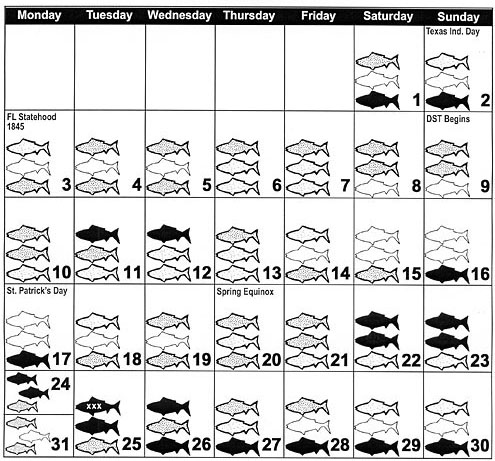
Total of 6 months advance planning capability in every issue!
